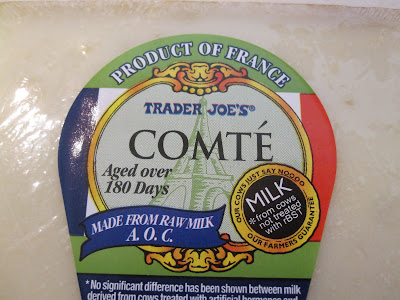Comte cheese is made from raw, unpasteurized cow's milk, in the Jura Mountains of the east central region of Franche-Comte which borders Switzerland.
It has an old origin, dating back to the time of Charlemagne. It has a light brown rind and a pale creamy yellow flesh and comes in a flat circular disc.
The picture below was taken while we were in England in 2006 at a street faire.
It has an AOC (appellation d'origine controlee) designation and can only be made in eight departments in France.
Raw milk from Montbeliarde cows is used and it must be used just shortly after milking. The milk is poured into a copper vat and warmed. Rennet, or another natural coagulation agent is added, within a stipulated time, which causes the milk to coagulate. It can't be heated any greater than 40 degrees C. The curds are cut and stirred and heated again for 30 minutes. The curds are then put into molds and the whey (liquid) is pressed out. A salty brine is regularly wiped on the surface of the cheese to encourage development of the rind mold. No salt can be put internally into the cheese. Maturing must be at least four months and no grated cheese can be sold under the Comte name. Each cheese is graded for overall appearance, quality of the rind, internal appearance, texture and taste. The highest scoring cheese is given a green label with the image of a bell (see the picture above) and can be called Comte extra. Any scoring below a certain level cannot be called Comte. The regular Comte comes with a brown label. Comte is usually aged 12 to 18 months. It must be aged at least four months and can be aged as long as 24 months. The difference in aging will create different flavors. The Comte I bought recently was aged six months. Wikipedia says the taste is "strong and slightly sweet." The France cheese website calls the taste "complex, nutty and caramelized." I found it was slightly sharp, a little sweet, and had a little of the unique taste I associate with Swiss cheese and am not fond of, although it has much less of that taste than Emmentaler cheese.
I like Comte much more than Emmentaler and prefer it to Gruyere (because of Comte's sharper taste), both of which are made in nearby regions. In fact, Comte is sometimes called Gruyere de Comte or French Gruyere. Like Emmentaler and Gruyere, which are mixed in fondues, Comte is often used for fondue.





No comments:
Post a Comment